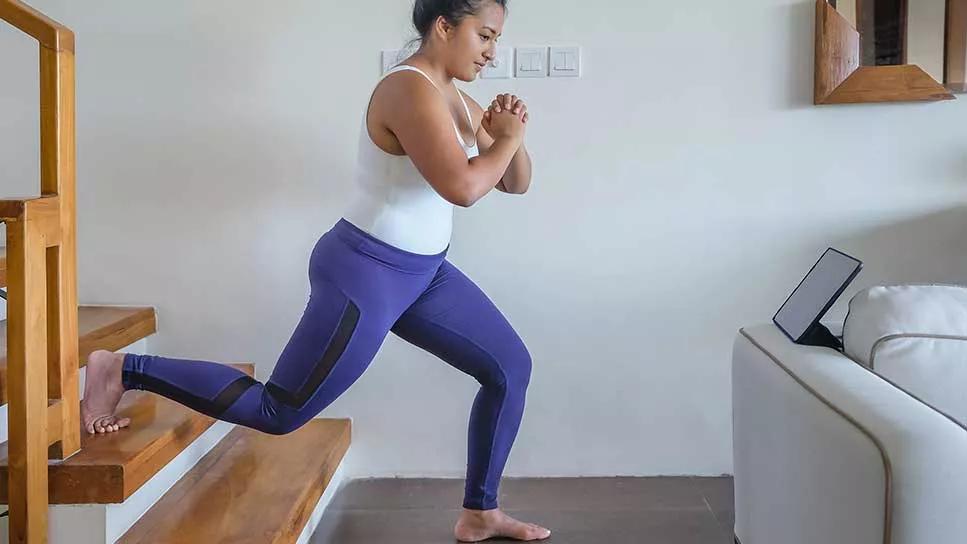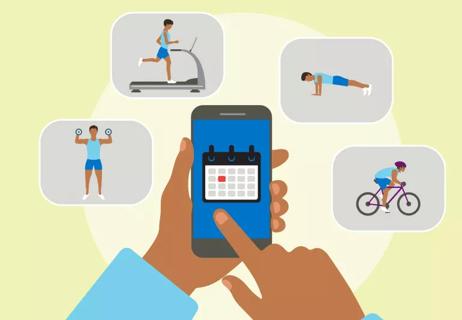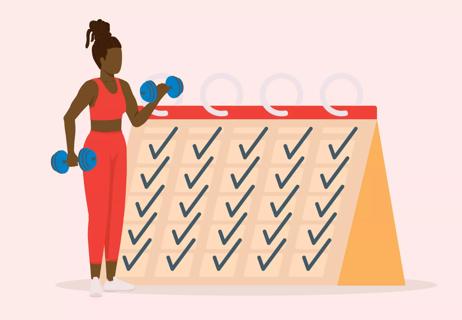Expect a few bumps in the road, work out for the right reasons and give yourself some credit

So, you’ve resolved to start exercising, and it’s going great ... at first. You have more energy. Your thinking is clearer. You’re seeing results.
Advertisement
Cleveland Clinic is a non-profit academic medical center. Advertising on our site helps support our mission. We do not endorse non-Cleveland Clinic products or services. Policy
Then, you start to slide. Your new workout clothes sit in the gym bag. And they’re starting to smell. When that app on your phone tells you it’s time for a walk, you dismiss it. Again.
Sound familiar? You’re not alone.
The American College of Sports Medicine (ACSM) recommends 150 minutes of moderate-intensity aerobic activity each week, plus strength-building exercises twice per week.
But data from the U.S. Centers for Disease Control and Prevention (CDC) say that less than 25% of adults meet those standards. And researchers estimate that half of people who begin an exercise program will drop out within six months.
Whether you’re hoping to improve your heart health, drop a few pounds or just feel more energetic throughout the day, getting moving is a great first step. But it can be hard to keep up with an exercise plan after the original luster wears off.
It’s time for a new perspective on your exercise plan to stay motivated to workout.
We talked with certified personal trainer Alena Beskur, ACSM-CPT, for some ideas to keep you motivated to reach your fitness goals.
You probably already know that exercise is important for your physical and mental health. But that doesn’t mean it’s easy to keep up with.
Advertisement
Life gets busy. The goals you set for yourself seem out of reach. And you just don’t feel like hitting the gym.
Beskur says beginning exercisers most often give up on their exercise-related goals because they grow frustrated when they don’t see results quickly. Or they try to do too much too fast and burn out.
“Exercise isn’t magic — it’s hard work that takes effort and time,” Beskur says. “It’s important to approach your fitness goals with a sense of patience and persistence.”
How can you avoid falling off the exercise train shortly after you get on? Beskur offers these tips.
Sticking with an exercise plan is tough work. And if you’re going to stay motivated to reach your goals, knowing why you’re exercising can make a difference.
Some people start working out because they’re motivated by something extrinsic, or outside of themselves. Maybe you want to fit into that favorite pair of pants again or you’re training for a half marathon.
Other people start with what’s called intrinsic motivation, or a reason to work out that comes from within themselves. They’re exercising because it makes them feel good or because they know it’s good for their health.
Research suggests that people with this second kind of motivation are more likely to stick to an exercise program long-term.
“If the motivation comes from within, you’re more likely to stick with exercise much longer because you don’t have a specific ‘due date,’” Beskur explains. “This is often the case for many people who have diabetes or heart disease. They become intrinsically motivated because they know exercise will help them in the long run.”
Consider these benefits of exercise to help hype yourself up to stick to your routine:
How’s that for workout motivation?
It’s easy to begin an exercise program with high hopes for instant results. Unfortunately, that’s not necessarily the way it works. And when you set your sights too high, it can be easy to lose exercise motivation when reality sets in.
“If you’re starting from zero, you need to set the bar low enough to be realistic,” Beskur says.
In other words, you’re probably not going to lose 10 pounds in a week (not in a healthy way at least). And you likely won’t be able to do a pull-up on your second try. And you might not fall in love with the process right away.
Advertisement
“I warn beginners from the start that exercise may not necessarily be the most fun, entertaining hour of their day,” she adds.
Start your workout commitment by setting goals. But not just any goals. SMART goals. SMART is an acronym for goals that are:
For example, if your fitness goal is to “lose weight,” it can be easy to lose motivation because you don’t have a plan for how exactly to achieve that goal. Or a point of reference for what your success will look like.
A SMART goal for weight loss could be something more along the lines of: “I’ll increase my average step count from 6,000 steps per day to 7,000 steps per day for the next three months.”
If you’re just getting started, don’t be tempted by the newest, flashiest fitness class on the block. It’s better to establish a routine with basic cardio and strength training movements that are both accessible and sustainable.
For example, if you’ve never been someone who goes to the gym, it’s probably unrealistic that you’re going to hit the cardio room five days a week. It’s likely too much of a disruption to your daily life to keep up with. You may for a short period of time, but you’re more likely to lose motivation quickly.
Advertisement
Instead, start small with activities you enjoy and can more easily fit into your day. That could be things like:
Once you’ve established a strong base, you can add on additional activities slowly, if that’s what you want.
We tend to think of exercise as a separate activity that we perform during a certain hour of the day — like when we put on our stretchy pants and head to the gym. But Beskur notes that people actually get most of their training outside of the fitness setting.
Think about it — every time you walk up the stairs or stand up from a chair you’re working muscles in your legs.
“It can be motivating to shift your perspective and see exercise not as a separate hour of the day, but as something we practice throughout the day,” Beskur suggests.
Give yourself a pat on the back for incorporating these daily activities into your routine. That can help you recognize the good you’re doing for your body, even if it doesn’t feel like work.
Instead of trying to cram in gym time on days where it just doesn’t work, focus instead on the body-moving activities you can do that still count as exercise. That can include things like gardening, cleaning, riding your bike, walking the dog or dancing.
Advertisement
We live in a go-go-go world. But your body needs rest to repair the muscles that have broken down during exercise.
Change your mindset around rest days to help keep up your fitness motivation.
When that demoralizing little voice in the back of your head tells you to go for a run on your rest day, remind it that stretching or taking a walk is important to your workout recovery.
It’s easy to lose motivation when you start to veer off course. But the point of your exercise plan shouldn’t be to make you feel bad when things go off track. Instead, expect you’ll hit a road bump here and there. And know that it’s OK.
If you can’t keep up with your plan to exercise five days a week, give yourself the benefit of cutting back to three. And when you come down with a cold and take a few days off, that doesn’t mean your whole month is doomed.
“If you exercise for five minutes a day, you’ll be better than you are if you’re not doing anything,” Beskur reminds us.
It’s easy to lose motivation to exercise with a belly full of greasy burgers and fries.
Food is fuel for your body. And the quality of what you put into your body directly affects how you’re able to perform.
“There’s no movement happening if we don’t feed ourselves well,” Beskur says.
Not sure where to start? Try incorporating more fruits, veggies, lean proteins and healthy fats to fuel your body.
New routines and habits can benefit from some outside help.
Consider asking a friend to join you on your fitness journey. You can help motivate each other to stick to your goals. A personal trainer can also work with you to create and stick with an exercise routine that will help you meet your goals. And of course, it’s always a good idea to talk with a healthcare professional before starting a new exercise routine.
Happy moving!
Learn more about our editorial process.
Advertisement

The exercise — which you’ve probably been doing since grade school — can be intimidating, but proper form can help

Exercise lowers risk for heart conditions, improves mental health and reduces visceral fat that can compromise your organs

Ask questions, get referrals and consider if someone is a good fit for you and your fitness goals

Jump into the swing of things to improve your coordination, burn calories and get your heart rate going

Walking with a weighted backpack is a low-impact, full-body workout that’s growing in popularity

A super high heart rate means you’re burning more than fat

Meet your workout goals by accounting for frequency, intensity, time and type

This modified challenge offers a head start on healthier habits

Type 2 diabetes isn’t inevitable with these dietary changes

Applying a hot or cold compress can help with pain